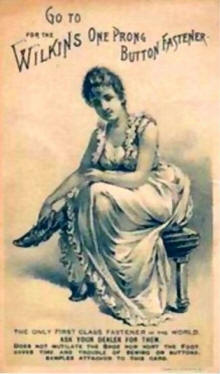 The
purpose of this section is to provide background, discussion, and visual examples of button
hooks as defined in Div IV, Section 4 of the NBS Classification and
Competition Guidelines1 (Blue
Book).
The
purpose of this section is to provide background, discussion, and visual examples of button
hooks as defined in Div IV, Section 4 of the NBS Classification and
Competition Guidelines1 (Blue
Book).References to the useful tool we call the button hook date back to the early 17th century, and some collectors have button hooks dating to the early 1800s. However, most button hooks found in collections today were made between the 1860s and 1930s. They came into very common use with women's high button-up boots and shoes around 1880, and persisted until after World War I. Shoes for both men and women in the late 1800s were generally made of stiff leather or serge, with between 2 and 26 buttons; getting the buttons through the buttonholes of the stiff material could be a daunting task. Later, children's leggings or gaiters saw widespread use, requiring their own button hooks. Women's gloves were often adorned with as many as 20 small buttons. Button hooks ranged in size from less than an inch to around 2 feet in length but generally were about the size of a fork. Use of the button hook involved inserting the hook or loop through the buttonhole and positioning it around the shank of the button. With a tug and a twist, the button was pulled through the buttonhole into the desired position.
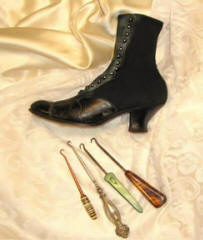 Over time, button hooks came to be combined with other tools including shoe
horns, corkscrews, knives, scissors, and fingernail files. Because everyone
needed them, button hooks became a common means of advertising with the
names of products, manufacturers, stores, and special events stamped or
engraved on them. After six decades as a common household item, the button
hook faded toward obscurity when button-up shoe styles lost their popularity
during World War I. Although their utility had disappeared by 1930, their
popularity as collectibles has grown ever since. Many who are "hooked" on
this affordable and available collectible belong to "The Buttonhook
Society." The society is based in the UK, has an international membership,
and operates an excellent website listed as reference 2 at the bottom of the
page.
Over time, button hooks came to be combined with other tools including shoe
horns, corkscrews, knives, scissors, and fingernail files. Because everyone
needed them, button hooks became a common means of advertising with the
names of products, manufacturers, stores, and special events stamped or
engraved on them. After six decades as a common household item, the button
hook faded toward obscurity when button-up shoe styles lost their popularity
during World War I. Although their utility had disappeared by 1930, their
popularity as collectibles has grown ever since. Many who are "hooked" on
this affordable and available collectible belong to "The Buttonhook
Society." The society is based in the UK, has an international membership,
and operates an excellent website listed as reference 2 at the bottom of the
page.So, what does the new collector look for when attempting to create a good representation for button hooks? The Blue Book divides button hooks into three classes of characteristics. These are 4-1, Functional design which includes button hooks, glove hooks, loops, fobs, and mechanical; 4-2, Handle design which includes advertising, art nouveau, trench art, figural/realistic, and pictorial; and 4-3, Specific design features. Class 4-3 allows and supports writing awards that focus on specific characteristics such as material types, construction techniques, decorative finish (DF), other material embellishment (OME) and pictorials. See the footnote at the end of Div IV listing in the Blue Book.
|
Note to the Viewer - Since the front and back views of button hooks
are very similar, the mouse does not turn over the images below for a back view as in most other division IV sections. |
|||||
|---|---|---|---|---|---|
| 4-1 Functional Design (button hooks, glove hooks, loops, fobs, and mechanical) | |||||
 4-1 Button Hook (5-1/2") (Metal/Wood/Bone/Composition) Hook greater than 1/2 inch |
 4-1 Fob (Ring on Handle) Mosaic (2-3/4") |
 4-1 Button Hook (10-1/2") Hook greater than 1/2 inch (Wood) Patent - Feb. 26, 84 |
 4-1 Glove hook Hook less than 1/2 inch (Moss Agate) (2-1/2") |
 4-1 Button Hook Hook greater than 1/2 inch (Steel) (5-1/2") |
|
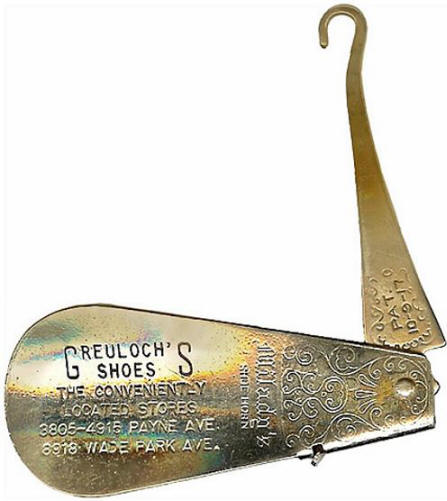 4-1 Mechanical - Folding Brass Shoe Horn/Hook (5") (Patent "10-9-17) |
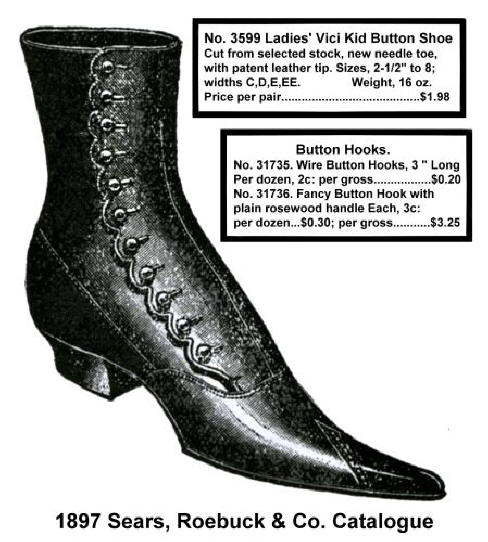 |
||||
 4-1 Fob (Ring on handle) (6") Brass (Mechanical - Telescoping) |
 4-1 Loop hook (1-7/8") Brass Fob |
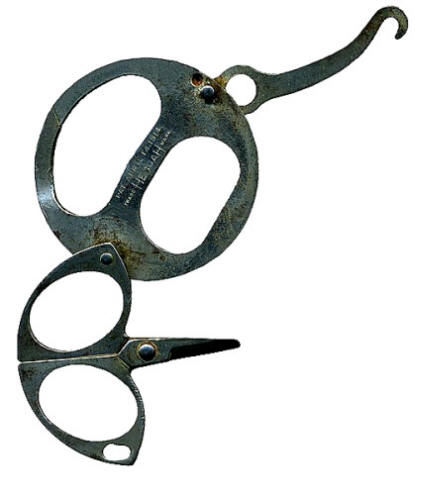 4-1 Mechanical - Tools Steel Hook/Scissors (2-1/2") |
|||
 4-1 Mechanical - Multiple tools as labeled |
 4-1 Mechanical - Folding Brass (3") |
||||
 4-1 Mechanical - Folding Brass (2-1/2") |
|||||
 4-1 Mechanical - Knife (2-1/2") Combination of Tools (Celluloid) |
 4-1 Mechanical - Tools (2-1/2") Pencil-pen knife- scraper-button hook |
 4-1 Mechanical - Folding Brass (3-1/2") Polished steel and brass Collet |
 4-1 Loop hook (4-1/2") Brass-Advertising |
||
| 4-2 Handle Designs (Advertising, Art nouveau, trench art, figural/realistic, pictorial) | |||||
 4-2 Art Nouveau - Sterling (8') |
 4-2 Figural - Celluloid (5-3/4") |
 4-2 Figural - Sterling (5-3/4") |
 4-2 Advertising - Steel (5-1/2") |
 4-2 Realistic - 14K Gold (2") |
|
 4-2 Art Nouveau - Nickel plated Fob (Ring on Handle) (7") |
 4-2 Pictorial (2") Brass and Steel |
 4-2 Pictorial - 14K Gold BM "Pat.10878" (8-1/4") |
 4-2 Art Nouveau - Sterling and MOP BM "115" (3-1/2') |
 4-2 Art Nouveau - Sterling (7") |
|
 4-2 Advertising - Steel (2-7/8') Patd. 1897 Aug. 10 |
 4-2 Pictorial - Sterling (4-1/2") |
 4-2 Art Nouveau - Sterling (5-1/2") |
 4-2 Pictorial (6-1/2") |
 4-2 Advertising (3-1/2") |
|
 4-2 Make Up (Kitchen Job) (4") |
 4-2 Advertising (3") |
 4-2 Trench Art (6") |
 4-2 Trench Art (5-1/2") |
 4-2 Figural - White Metal (3-5/8") |
|
|
Credits and References Credits: (1) 1897 Sears, Roebuck & Co. Catalogue, Chelsea House Publishers, 1968 Acknowledgements: Special thanks to the collaborators who made examples from their collections available for the images shown on this pages. They include P. Jean Champoux, Anne Frasier, Pat Koehler, Anne Marie Broom, Lou Yeargain, Suzanne Marsh, Shelly Strick and Anne Dickerson. Others who contributed reviews, comments and support include Pat Fields, Pat Koehler, and Barbara Barrans. Any corrections to the labeling or suggested improvements should be directed to the Button Country team at Contact Us. References: (1) National Button Society Blue Book, Official NBS Classification and Competition Guidelines (2) The Buttonhook Society - Maidstone, Kent ME14 9BA, United Kingdom - http://www.thebuttonhooksociety.com/mainpage.php. (3) Cynthia L. Compton: Buttonhooks, Collecting and Price Guide, Andrew Black & Associates, Publisher (4) Lena Jackson: Vintage Fashions, The Ultimate Authority, March/April 1990 (5) Kathy E. Kear: Antique Week, May 19, 1997 |
|||||